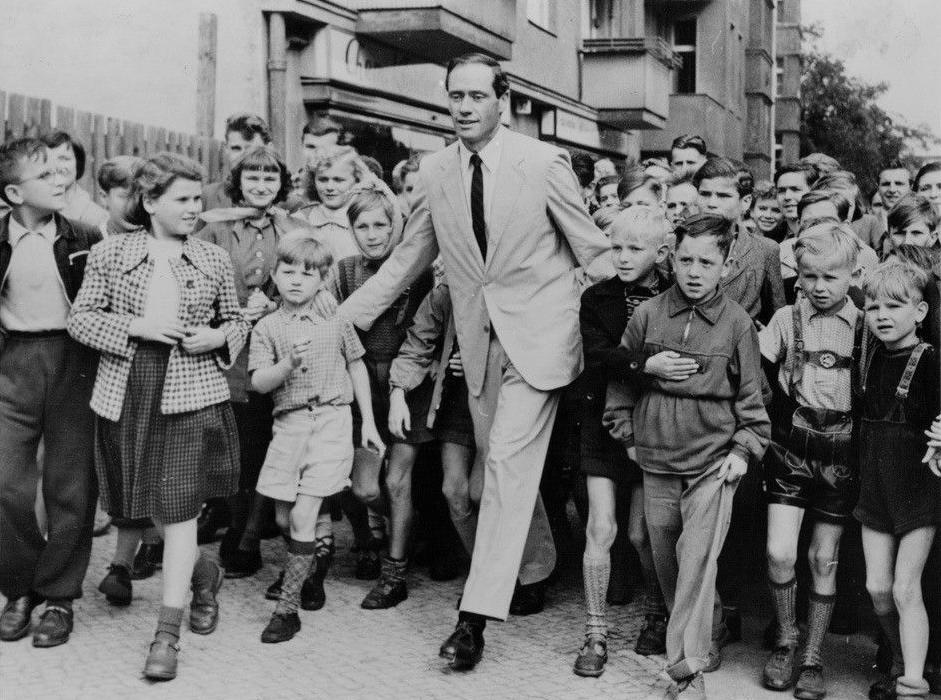
Refugee Movement Causes: Totalitarian Communism--East Germany

Figure 1.--The West Germans at the end of World War II were faced with a country in ruins and the need to care for and assimilste millions of ethnic-German refugees from Eastern and Central Europe, a monumental task. In less than a decade this was largely accomplished and the German Economic Miracle transforming Germany and with it all of Western Europe. West Germany also took in refugees from the Soviet occpation zones. The Soviets hardened the boorder wih the Western occupation zomes, but for 15 years there was one way out -- West Berlin. Here we see West Berlin children described as refugees in 1957. By this time, the World War II refugees had been resettled and largely assimilated. We believe that these were refugees from Communist East Germany who were still able to escape throiugh West Berlin, most as fmilies. The press caption read, "Berlin Children Guess of Mel Ferrer: Actor Mel Ferrer is shown with some of the 600 Berlin refugee children who were his guests at a showing of the film 'Lilli' in which he stars with Leslie Caron." 'Lilli' was about a French orphan.
|
|
Largely forgotten today is the German refugees crisis following World War II. It is one of the largest refugee crisis in history. The Germans and the Soviets launched World War II creating an refugee crisis even greater than World War I. The Germans were not greatly affected by the World War I refugee crisis because the War was fought for the most part in countries that the Germans had invaded. World War II proved different. For most of the WWar the pattern was similar, the war was fought in countries the Germans invaded. The final year of the War was different. German refugeess began moving west as the Soviet Red Army began approaching the Reich. At the nd of the War, areas of eastern Germany were annexed to he Soviet Union and Poland. Both Hitler and Stalin promoted ethnic cleansing policies. Germans fled or were driven from these areas. Soviet policy was that it was the responsibility of West Germany to absord these people. And other ethnic Germans arrived from other countries (Czechslovakia, Hungary, Romania, and Yugoslavia). These were people whose ancestors had lived there for generations. The behavior of NAZI authoriries were so brutal, however, tht most of these countries wanted the Germans out. And the expulsions were all too often accompanied by the kind of brutality that those people had suffered from the the NAZIs. Those Germans expelled are today referred to in Germany as " Vertriebenen " (expelled ones). The expulsion numbers are astonishing. It is believed that some 30 million people, including ethnic Germans (Volksdeutsche) as well as German citizens (Reichsdeutsche), were permanently or temporarily set in motion from Central and Eastern Europe (1944-48). [Magocsi, pp. 164-68.] All of of this was the result of a mix of NAZI and Communist policies. We do not hear much about it today because the Germans successfully assimitated the refugees in a very short period of time. Compares this to the much smaller number of Palistinian refugees at about the same time (1948-49), but the Arabs refuse to assimilate. In less than a decade the World War II refugees had been effectively assimilated. A much smaller refugee problem began in the aftermath of the post-War era--the Cold War regugees. Germans fleeing the Communist police state the Soviets imposed on their occupation zone. The borders were at first fluid, but fairly quickly the Soviets began to harden the border of their occuopation zone and their other Eastern European satellites. As the Iron Curtain formed, their was one leak in the dike--West Berlin. And Germans seeking freedom poured through it. The first Soviet attempt to close it failed with the Berlin Air Lift (1948-49). Ultimately it became untenable with people steadily leaving the Germn Democratic Reopublic (DDR). It was destabilizing the DDR despite the best efforts of the omunipresent secret police (Stazi). It was closed by the Berlin Wall (1961). It took the most formidable border obstacle in human history to stem the German desire for freedom, only ending with the the people of East Berlin bursting through the Wall leading to the collapse of the DDR.
Sources
Magocsi, Paul Robert. Historical Atlas of East Central Europe (University of Washington Press: 1993).
CIH

Navigate the Children in History Website:
[Return to Main refugee totalitarian causes Communism page]
[Return to Main refugee totalitarian causes page]
[Return to Main refugee causes page]
[Return to Main specific refugee group page]
[Return to Main refugee page]
[Return to Main children and war page]
[Return to Main war essay page]
[Introduction]
[Biographies]
[Chronology]
[Climatology]
[Clothing]
[Disease and Health]
[Economics]
[Geography]
[History]
[Human Nature]
[Law]
[Nationalism]
[Presidents]
[Religion]
[Royalty]
[Science]
[Social Class]
[Bibliographies]
[Contributions]
[FAQs]
[Glossaries]
[Images]
[Links]
[Registration]
[Tools]
[Children in History Home]
Created: 4:37 AM 9/15/2018
Last updated: 4:38 AM 9/15/2018



